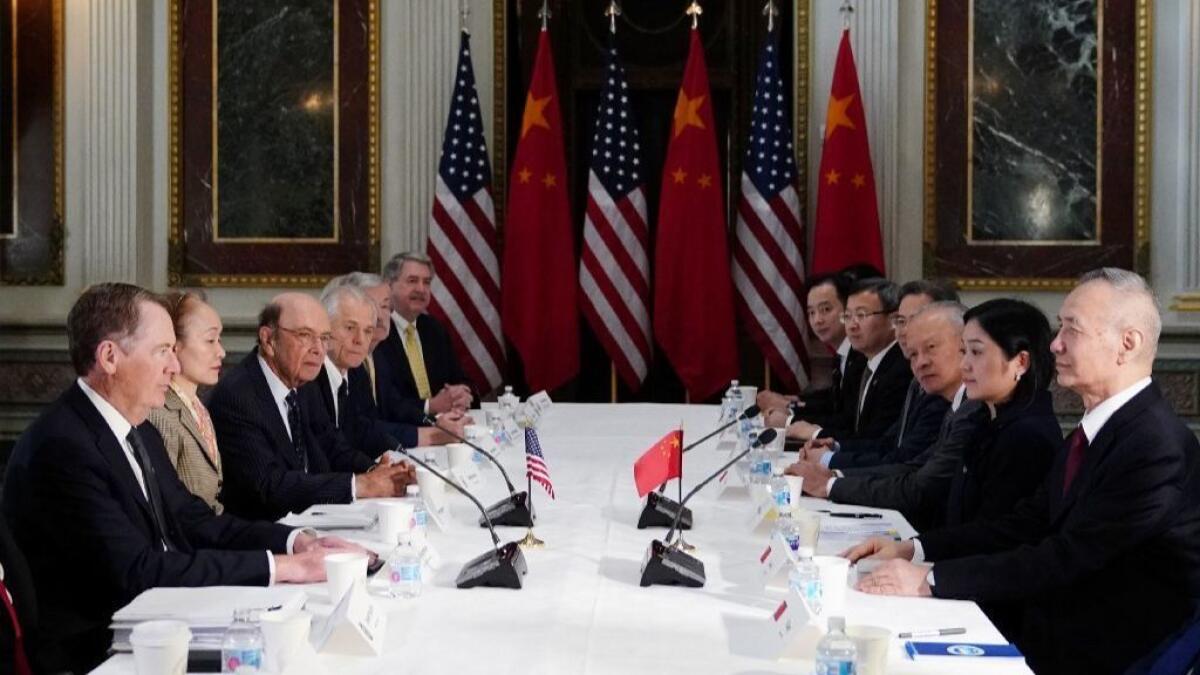Trump sees ‘good chance’ of trade deal with China as talks go into weekend

- Share via
Reporting from Washington — As U.S. and Chinese officials extended trade talks into the weekend, President Trump said Friday that the two sides have a “good chance” of reaching a deal, though he repeated that he and Chinese President Xi Jinping might well have to work out the final issues.
Trump said he and Xi could meet next month at his Mar-a-Lago estate, and again dangled the possibility of retreating from his threat to sharply boost tariffs on Chinese goods next Saturday if there is no deal.
“I can see extending that,” he said of the March 1 deadline that he set late last year, when he and Xi met on the sidelines of a summit in Argentina.
Trump spoke to reporters from the Oval Office as Chinese Vice Premier Liu He, Xi’s top economic official and leader of China’s negotiating delegation, looked on. Liu, speaking through a translator, said, “From China, we believe it is very likely that it will happen and that ultimately we’ll have a deal.” He read a letter from Xi that urged negotiators to “redouble our efforts so as to meet each other halfway.”
U.S. Trade Representative Robert Lighthizer, Trump’s point person on the China talks, was more circumspect. He said big hurdles remain, though on one important issue — China’s practice of essentially requiring foreign firms to give up their trade secrets to do business there — “We’ve made a lot of progress.”
The two sides have held four rounds of talks since Trump and Xi, at a Dec. 1 dinner meeting in Buenos Aires, called a 90-day truce in a trade war marked by tit-for-tat tariffs.
Trump launched the fight last summer by slapping 25% tariffs on $50 billion of Chinese goods, complaining about China’s large trade surplus and unfair trade practices. That was matched dollar for dollar by China.
In September, Trump imposed 10% tariffs on an additional $200 billion of Chinese imports and threatened to increase the duties to 25% on Jan. 1. In all, China has raised tariffs 5% to 25% on about $110 billion of U.S. merchandise.
The trade talks have come amid increasing U.S.-China tensions on other fronts.
The Trump administration has stepped up prosecutions of Chinese cyber-espionage and is seeking the extradition of a top executive of China’s biggest telecom firm, Huawei, on charges of violating U.S. sanctions on Iran. Although U.S. and Chinese officials have said the Huawei dispute is unrelated to the trade talks, Trump on Friday did not rule out that it would be part of any trade agreement.
“We’ll be talking about it. We may or may not include that in this deal, Huawei and ZTE,” Trump said, also referring to another Chinese telecom firm that has been subject to U.S. action.
Besides curbing China’s forced technology-transfer policies against U.S. firms, the United States is demanding major structural changes in China’s state-led economy, including stronger intellectual property rights and fair market access for foreign companies.
The two sides released no statement or details from the negotiations as high-level talks were to continue into the weekend.
China reportedly has offered to buy up to $1.2 trillion of U.S. goods in a move to narrow the trade imbalance and address a persistent complaint of the president’s.
Without elaborating, Trump said the two sides already have an agreement on “currency and currency manipulation.”
Analysts said that most likely meant a commitment from Beijing to keep the yuan above a certain level — something that the U.S. side sought, though past administrations pressed China to let market forces determine the value of its currency. The Trump administration’s grievances on trade have more to do with China’s nonmarket behavior.
“It’s filled with ironies and contrary to what the U.S. government has been saying to China for many years,” said Kenneth Jarrett, past president of the American Chamber of Commerce in Shanghai and now a senior advisor at Albright Stonebridge Group, a global strategy firm in Washington.
Nonetheless, the continuing discussions and indications that negotiators are making progress have raised optimism and lifted stock markets. With China’s economy slowing and signs of some softening in U.S. growth as well, analysts say both sides have incentives to resolve the trade conflict.
“Opposition to tariffs is steadily building, and Trump is not anxious to do something to spook the markets,” said Nicholas Lardy, an expert on China’s economy at the Peterson Institute for International Economics.
Yet big gaps still divide the two countries, Lardy said. It remains uncertain whether negotiators can resolve such difficult problems as China’s practice of subsidizing state-owned enterprises, which U.S. officials want stopped. About 40% of those firms are losing money, Lardy said, and many could collapse if state bank loans were cut off, risking social instability and backlash from local governments.
For the United States, the toughest issue on the table is how to ensure that Beijing will live up to its commitments rather than delay or act after it’s too late to have much benefit for U.S. companies.
“The Chinese could agree to a lot of things and not deliver,” Lardy said. “Then what are you going to do?”
More to Read
Inside the business of entertainment
The Wide Shot brings you news, analysis and insights on everything from streaming wars to production — and what it all means for the future.
You may occasionally receive promotional content from the Los Angeles Times.











